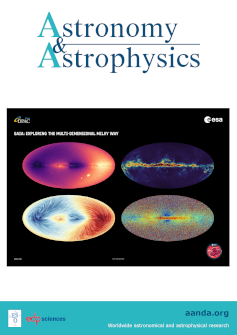Unlocking the mystery of strontium synthesis in the early Galaxy through analysis of barium isotopes in very metal-poor stars★
IF 5.4
2区 物理与天体物理
Q1 ASTRONOMY & ASTROPHYSICS
引用次数: 0
Abstract
Aims. We determine the contributions of the rapid (r) and slow (s) neutron capture processes to the Ba isotope mixture, along with Ba, Eu, and Sr NLTE abundances, in a sample of very metal-poor stars. The selected stars formed before the contribution from the main s-process in low- and intermediate-mass stars became significant. Some of our sample stars are enhanced in Sr, with [Sr/Ba] reaching up to 0.7. These stars gained their high Sr abundance from a poorly understood process, sometimes referred to in the literature as a light element primary process, which may appear to be a weak s-process or a weak r-process. Our aim is to uncover the nature of this additional Sr source.Methods. The abundances derived from the resonance Ba II 4554 and 4934 Å lines are influenced by the adopted Ba isotope mixture. We computed Ba isotope mixtures corresponding to different r- to s-process contributions (pure r-process, 80%/20%, 50%/50% and 12%/88%, i.e. solar ratio) and determined the corresponding abundances from the Ba II resonance lines in each sample star. Additionally, we determined Ba abundances from weak subordinate Ba II lines, which are unaffected by the adopted Ba isotope mixture. We then compared the Ba abundances derived from the subordinate lines with those from the Ba II resonance lines.Results. We find a higher s-process contribution to Ba isotopes in stars with greater [Sr/Eu] and [Sr/Ba] overabundances, suggesting that the additional Sr synthesis was due to the early s-process occurring in massive stars. Using Sr-enhanced stars, we estimate the [Sr/Ba] ratio produced by the early s-process and obtain [Sr/Ba]earlyS = 1.1 ± 0.2. The derived value should be regarded as an upper limit, as we cannot definitively exclude the possibility of a contribution to Sr from the weak r-process, which produces Sr but not Ba. Regarding the potential synthesis of Sr and Ba in the i-process in massive stars, our results for Ba isotopes and element abundances argue that there was no detectable contribution from this process within the error bars in our sample stars.Conclusions. In the early Galaxy, before significant main s-process enrichment, barium and strontium were produced primarily by the main r-process and the early s-process, which occurred in rapidly rotating massive stars.通过分析金属含量非常低的恒星中的钡同位素,揭开了早期银河系中锶合成的神秘面纱
目标。我们确定了快速(r)和慢速(s)中子捕获过程对Ba同位素混合物的贡献,以及Ba, Eu和Sr NLTE丰度,在金属非常缺乏的恒星样本中。在低质量和中质量恒星的主s过程的贡献变得显著之前,所选择的恒星形成。我们的一些样本恒星的Sr增强了,[Sr/Ba]达到0.7。这些恒星的高锶丰度是通过一个鲜为人知的过程获得的,有时在文献中被称为轻元素初级过程,这可能是一个弱s过程或弱r过程。我们的目标是揭示这个额外的锶来源的性质。共振Ba II 4554和4934 Å谱线的丰度受Ba同位素混合物的影响。我们计算了不同r- s过程贡献(纯r-过程,80%/20%,50%/50%和12%/88%,即太阳比)对应的Ba同位素混合物,并从每个样品恒星的Ba II共振谱线确定了相应的丰度。此外,我们还从弱次级Ba II系测定了Ba丰度,该系不受所采用的Ba同位素混合物的影响。然后,我们比较了从从属谱线得到的Ba丰度与从Ba II谱线得到的Ba丰度。我们发现,在[Sr/Eu]和[Sr/Ba]丰度更高的恒星中,s过程对Ba同位素的贡献更高,这表明额外的Sr合成是由于大质量恒星中早期的s过程发生的。利用Sr增强星,我们估计了早期s过程产生的[Sr/Ba]比值,得到[Sr/Ba]早期ys = 1.1±0.2。导出的值应被视为上限,因为我们不能明确地排除弱r过程对Sr的贡献的可能性,弱r过程产生Sr而不产生Ba。关于在大质量恒星的i过程中可能合成Sr和Ba,我们对Ba同位素和元素丰度的结果表明,在我们的样本恒星的误差条中没有可检测到的这一过程的贡献。在早期的银河系中,在显著的主s过程富集之前,钡和锶主要是由主r过程和早期s过程产生的,这发生在快速旋转的大质量恒星中。
本文章由计算机程序翻译,如有差异,请以英文原文为准。
求助全文
约1分钟内获得全文
求助全文
来源期刊

Astronomy & Astrophysics
地学天文-天文与天体物理
CiteScore
10.20
自引率
27.70%
发文量
2105
审稿时长
1-2 weeks
期刊介绍:
Astronomy & Astrophysics is an international Journal that publishes papers on all aspects of astronomy and astrophysics (theoretical, observational, and instrumental) independently of the techniques used to obtain the results.
 求助内容:
求助内容: 应助结果提醒方式:
应助结果提醒方式:


